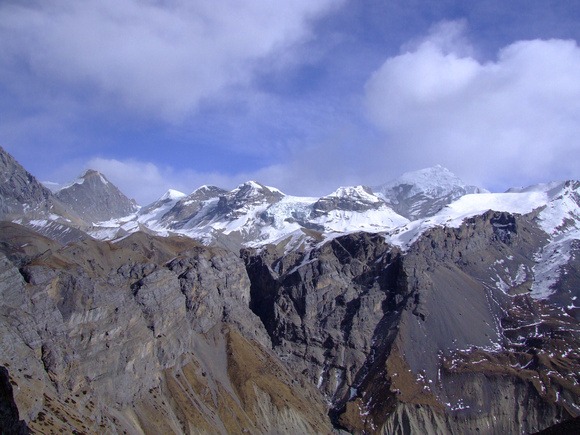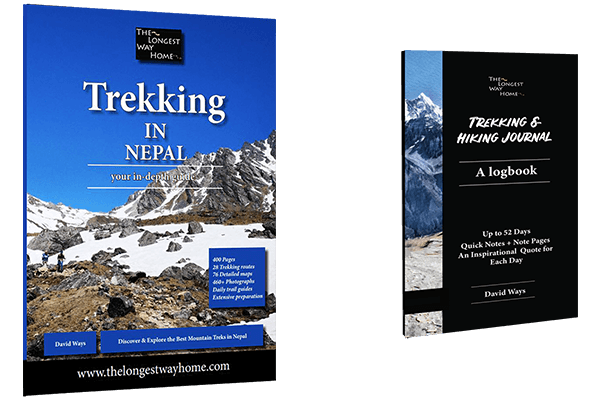

The Himalayas Are Still There: Debunking the BBC’s Hazy Himalayan Hype
I have been traveling, living, and writing about Nepal for over two decades, trekking its trails, tasting high-altitude coffee in Kathmandu’s bustling Thamel, and staring in awe at the jagged, snow-draped Himalayas from mountain peaks. So when I stumbled across a recent BBC article (source) claiming the mighty Himalayas are “getting harder and harder to see” due to haze and pollution, I raised an eyebrow. The piece, penned by an environment correspondent, paints a dramatic picture of vanishing mountain views, disappointed tourists, and a trekking industry on its knees. But as someone who’s been on the ground, I’m calling this out for what it is: clickbait with more holes than a yak’s wool sweater.
Let’s unpack this, shall we? I’m not denying air pollution or climate challenges in Nepal: those are real. But the narrative that the Himalayas are practically invisible now, even during peak seasons, is wildly exaggerated. Here’s my take on Himalayas visibility in Nepal, grounded in experience, not hype.
The Kathmandu Mountain Myth
The article kicks off with a nostalgic claim about seeing the Himalayas from Kathmandu’s city streets. Look, I have spent countless days wandering Kathmandu, from the narrow alleys of Ason to the rooftops of Patan. I have a dedicated heritage book that covers places few have ever seen, all the way to the tallest temple. The idea that you could casually gaze at Everest or Annapurna from the capital is a stretch, and it has been for decades. Urban sprawl, buildings, weather, and distance, mean the mountains are rarely visible from the city itself. On a crystal-clear day, post-monsoon in October or November: but more likely in the depths of winter, you might catch a glimpse of distant peaks from Patan’s higher spots or a rooftop in Boudha. But this isn’t new, and it’s not pollution’s direct fault; it’s geography.

Want to see the Himalayas? Get out of Kathmandu. Head to Dhulikhel, a short drive east, where on a clear winter’s day (October to February), the views are jaw-dropping. Or book a mountain flight for a front-row seat to Everest. That’s all without trekking. The article’s lament about not seeing mountains from a Kathmandu hotel is baffling. No hotel in the city has ever marketed itself as a Himalayan viewpoint, and if they did, they’re selling snake oil. This sets the tone for the piece: dramatic but disconnected from reality.

Haze, Fires, and the Springtime Scapegoat
The BBC points to “severe air pollution” and haze as the main culprits obscuring the Himalayas, even during the spring (March to May) and autumn (October to November) seasons, which are traditionally clear. Let’s break this down.
Haze in spring is real, but it’s not some new phenomenon. Across Nepal, India, Pakistan, and indeed much of Asia, farmers burn grass and crop residue in the dry season to prevent uncontrolled forest fires later. These controlled burns create smoke, which can linger as haze, especially at lower altitudes. This isn’t unique to Nepal: it’s a regional issue across Asia. I’ve seen it in Pokhara, where locals once pointed fingers at India, conveniently ignoring their own fires nearby. Is it ideal? No. Does it blanket the Himalayas year-round? Absolutely not.
The article claims haze is now so bad that even spring and autumn are ruined. That’s a stretch. Mid-October to mid-December is Nepal’s golden window—post-monsoon, pre-winter. Skies are typically blue, and above 4,000 meters, you’re almost guaranteed epic views, if the weather cooperates. March to May can be hazier due to fires, but it’s not a write-off. I’ve trekked the Annapurna Circuit in April and seen Poon Hill light up with sunrise over Dhaulagiri. The key? Altitude and timing. Below 4,000 meters, haze can be an issue in spring, but climb higher, and you’re above it.
The piece also mentions a flight circling Kathmandu’s airport 20 times due to hazy weather. Congestion at Tribhuvan International Airport is infamous, exacerbated by ongoing repairs and outdated radar. Delays and circling have been a fact of life at the airport for over a decade, haze or no haze. Try landing during monsoon season! Blaming it solely on pollution is lazy.
Nagarkot and Annapurna: Misplaced Expectations
The article cites Nagarkot, a hill station near Kathmandu, as a prime example of haze-ruined views. I’ll be blunt: Nagarkot has never been a stellar Himalayan viewpoint. Decades ago, guidebooks like Lonely Planet hyped it up, and tourists bought the myth. Even on a clear day, you’re not seeing Everest without binoculars along with some imagination, and the other “spectacular” peaks are distant at best. A local hotelier quoted in the piece says he’s stopped marketing Nagarkot for sunrise and Himalayan views, focusing on history and culture instead. Smart move, but this isn’t news: Nagarkot’s reputation as a mountain vantage point was always overstated. I’ve written about this in my guidebook to Nepal over 10 years ago and given better alternatives than the tourist trap of Nagarkot.


Then there’s the Annapurna region, where the writer claims they “had hardly any luck” seeing peaks during a trek. The Annapurna region is vast, from Pokhara’s Sarangkot to the high passes of Thorong La. Without context—where exactly were they trekking? This is meaningless. Sarangkot, the concrete-heavy viewpoint near Pokhara, isn’t prime for Himalayan vistas. But on a trek like Annapurna Base Camp or the Annapurna Circuit, haze is rarely an issue above 3,500 meters, especially in October or November. If clouds rolled in, that’s weather, not pollution. I’ve lost count of trekkers who’ve had bad luck with clouds one day and postcard-perfect views the next. That’s mountain life!

The Trekking Industry’s “Crisis”
The BBC quotes a trekking guide claiming a 40% business drop due to hazy conditions, even mentioning compensating trekkers for not seeing mountains. I’ve been in Nepal’s trekking scene long enough to call this dubious. A 40% drop? Let’s talk real factors: the 2023 ban on independent trekking by the Nepal Tourism Board and Trekking Agencies Association of Nepal (TAAN), skyrocketing costs, and a string of plane crashes haven’t exactly screamed “book your trek now.” Blaming haze alone is absurd.
As for compensating trekkers for weather? I’ve never heard of a reputable agency doing this. Weather is unpredictable: always has been. If you’re promised a guaranteed view of Annapurna, you’re being scammed, not compensated. The article also cites a trekking official saying operators are “depressed” and considering career changes. Hyperbole aside, the industry faces challenges, but haze isn’t the apocalypse. Trekkers still flock to Nepal, and those who research their trips, choosing the right season and altitude—rarely leave disappointed. All the same, it can happen, just like anywhere in the world when out of 365 days in a year you are only there for 14. You take a risk with weather whenever you go on holiday. You mitigate it by going at a time of year when it’s historically rain or cloud free, but it’s still no guarantee … anywhere in the world. Nepal just happens to be on the roof of the world and has fairly dependable weather patterns.

The Bigger Picture: Pollution, Climate, and Reality
Let’s not sugarcoat it: air pollution is a problem in South Asia. Cities like Kathmandu, Delhi, and Lahore regularly rank among the world’s most polluted. Vehicle emissions, construction dust, and open waste burning contribute year-round. Grass fires, as I mentioned, add to the spring haze. Climate change is extending dry seasons, which can worsen conditions. The BBC cites Pokhara’s airport recording 168 hazy days in 2024, up from 23 in 2020. I’d take that data with a grain of salt: Nepal’s weather stations aren’t exactly cutting-edge, and Pokhara’s new airport has its own issues, like lacking radar for wide-body jets, hills blocking radar, etc. Weather stations in the mountains … dream on. Most weather patterns in the mountains are calculated based on satellite imagery coming from India.
To claim the Himalayas are now only visible in “photographs, paintings, and postcards” is pure drama. I was in Langtang last November, and the peaks were so clear I could’ve counted the crevasses. Above 4,000 meters in the first season, haze is rarely a factor, and even at lower altitudes, the post-monsoon season delivers. If the weather is cloudy … it’s the weather and bad luck. There’s a difference. The article’s doom-and-gloom ignores the reality: Nepal’s peak seasons (mid-September to mid-December, and to a lesser extent, Late March to May) still offer some of the world’s best mountain views, if the weather cooperates. Which in Nepal, it generally does.
There are no guarantees with the weather … bad guidebooks, marketing hype, and promotional blather have risen expectations for mountain views into near guarantees – it simply never has been the case – the fires? It’s been going on for decades – mix them with no wind (weather) and yes there can be a problem. But, again, it’s been that way for decades across Asia, not just in Nepal.

So, What’s the Deal with Trekking in Nepal?
This BBC piece is a classic case of sensationalism over substance. It takes real issues: pollution, climate change, and seasonal haze, and spins them into a narrative that the Himalayas are vanishing. The truth? They’re still there, as majestic as ever. Here’s my advice for travelers:
Practical Tips for Trekkers
- Time it right: Mid-September to mid-December is your best bet for clear skies. March to May can work, but expect some haze at lower altitudes. Check out the best time to visit Nepal.
- Go high: Above 4,000 meters, haze is minimal. Treks like Everest Base Camp or Annapurna Circuit deliver. Need to know what treks go over 4,000 meters?
- Skip the hype spots: Low-altitude peak season – Nagarkot and Sarangkot are overrated. Try Dhulikhel or a mountain flight for better views.
- Manage expectations: Weather is unpredictable everywhere, from Nepal to New York. No one guarantees blue skies, and if they do, they’re lying.
- Support solutions: Grass fires are a regional issue. Advocate for better fire management and environmental management, not just in Nepal but across Asia. Why are North America and Europe implementing campfire bans, coal bans, and all sorts of pollution bans on the public when across Asia new coal power plants are opening, rubbish zones burn, recycling is nearly non-existent, diesel generators generate electricity, and grass fires are lit?
Pollution is a global challenge, and Nepal’s doing better than many. Hydropower dominates its electricity, and electric vehicle sales are climbing. Grass fires remain a problem, but they’re controlled to prevent worse forest fires. Science needs to step up with solutions, not just for Nepal but for the world.
Final Thoughts
The Himalayas aren’t going anywhere, and neither is Nepal’s allure for trekkers and adventurers. The BBC’s article is a well-meaning but misleading mix of half-truths and hyperbole, leaning on outdated guidebook myths and vague anecdotes. As someone who’s trekked Nepal’s trails for years, I can tell you the views are still there: provided you know when and where to look.
Want more trekking tips? Check out my Trekking in Nepal Guidebook for insider advice!
Don’t let clickbait scare you off. Do your research, pack your boots, and chase those peaks. The Himalayas are waiting, haze or no haze.
Get My Trekking in Nepal Guidebook & Discover More Than Anyone Else!
Looking for more insider tips and information like this? Get the most up-to-date, popular, and dedicated guidebook to Trekking in Nepal in the world. Covering 29 full treks over 400 pages. The only trekking guidebook in the world with trekking links showing you how to link treks together! Available as an instant download or worldwide shipping for the paperback edition!
Take a look below and you’ll find out why this beats all other guidebooks! 
Get the Trekking in Nepal guidebook here!
Get the paperback Trekking & Hiking Journal here!
Or


As an environmental journalist myself, I found your balanced take on pollution versus natural haze refreshing. The BBC article felt sensationalized.
However, your point about controlled grass fires being a regional practice across Asia adds important context that was missing from their piece. It is something that needs to be addressed across Asia. If it was happening in Canada there would be outrage due to the forest fires alone.
Thanks for the kind words. Yes, I’ve come across grass burning across Asia from Thailand to The Philippines, India and indeed Nepal. While people complain about the environmental impact of having a barbecue in some countries, others light up entire hillsides. Again, China’s coal burning power-plants …
The BBC and old school news media has been blowing smoke for the past few years. Happy to see you called them out on this one. We need more like you David.
It’s a struggle to read the news sometimes the way everything is depicted as being so negative these days
As someone who’s trekked to EBC and APC (2019 and 2023), I can confirm the views above 4000m are still absolutely spectacular. That BBC article had me second-guessing my planned return trip, but your firsthand account is reassuring as is my own. The media really does love a dramatic narrative over actual facts
Glad to hear you had clear views on both your trips Mark!
Thank you for this reality check! I was in the Annapurnas last October and the mountain views were breathtaking – nothing like the doom and gloom that article suggested. Your point about managing expectations is spot on; weather has always been unpredictable in the mountains.
October is a good time of year! November into December also for the Annapurna’s. Glad you got to see them.
Been trekking in Nepal for over a decade and the mountains are definitely still there! Your comment about the 40% business drop being more likely due to the trekking ban and rising costs rather than haze hits the nail on the head. Nepal has become more expensive and the roads are still badly built. The whole industry has bigger issues than seasonal weather patterns.
Yes, ban solo trekking and there will be a drop in tourism … let alone world events like the cost of living increasing. There’s more to tourist drops than weather alright!
I’ve been following your blog for years and appreciate your honest, no-nonsense approach. The comparison between seasonal haze from controlled burns versus actual pollution is something most travel writers miss completely. Your advice about going above 4000m altitude is gold.
Thanks Andreas. It just my style. I like the blunt truth so I know exactly what I’m getting. So, I write the same way. It annoys some people when they don’t like the facts, but in terms of debunking the Nepal haze issue, it irks me to see people exasperate a situation so much.
We returned from Nepal March of this year and can attest to everything you’ve said here. Yes there was dust. Yes it’s not like Arizona … but no we were not expecting it to be, that’s why we went to Nepal and used your guidebook! We did see Dhaulagri and other massive peaks. The week before our guide said they were not visible. Clouds came in during the early afternoon. Sometimes it parted in the evening. In the morning the weather was fantastic. The BBC piece felt like they were writing about a completely different country.
Nice to know you found similar conditions and got to see the big mountains. Having an extra day when trekking often helps. Yes, the BBC article was a lot of hype and not much substance.
Long term reader, first time commenting. Your debunking of the Kathmandu mountain views myth is brilliant. I fell for that trap, expecting to see Everest from my hotel window! Just like the hotel booking site showed. Now I know better thanks to guides like yours. The media really needs to stop perpetuating these unrealistic expectations.
Good to have you here Lars. Pokhara is another place the brochures love to show mountain views from hotels. Yes, many do. But the photoshopping on many is pretty much standard these days.
I found the pollution to be quite severe in Kathmandu. We are simply not used to it. All the brochures and websites never mentioned except for yours. We had and used dust masks. On our Poon Hill trek we did see haze but we were fortunate enough that on out actual day going up Poon Hill our guide took us in the early morning and we saw clear white mountains.
Yes, pollution in the big cities is a problem. I do recommend dust masks. The good news is that hydro power in Nepal is generating most of the electricity now to the point there’s a surplus. Electric cars are appearing everywhere and it’s getting better. However, if you come from a country with no pollution or are not used to Asia then it can still be a shock to experience. Glad your got to see the mountains from Poon Hill.
Many people think the haze ruins the entire trekking experience, but that’s just a half-truth. Glad to read your fresh perspective, showing how timing and location matter more than myths. It’s reassuring for trekkers who dream of those iconic mountain views. I liked how it blends facts with practical tips. The haze may come and go, but the Himalayas are still as majestic as ever. A great read for anyone planning their first Himalayan adventure.
Thank you. Yes, it’s easy to write up about trekking in the middle of monsoon season and then coat it as if this is the entire years experience. Better to get a complete breakdown to know when it is really good to go.
This is exactly what I was looking for. Straightforward and useful without too much fluff — thanks for the insights!
Glad it helped!